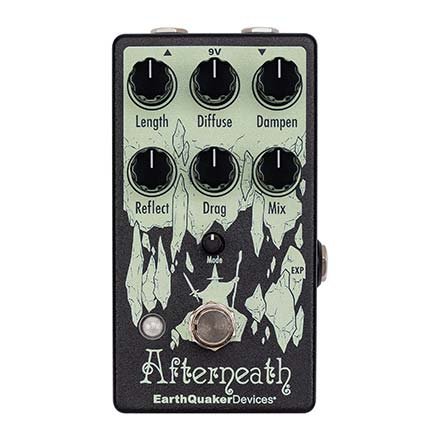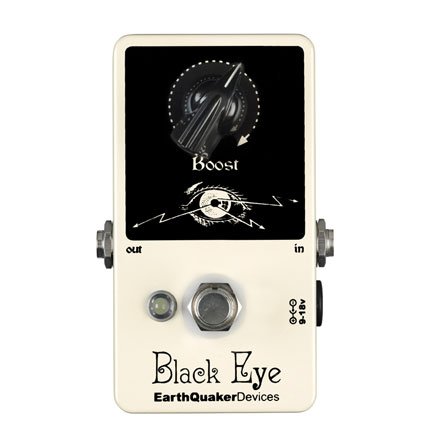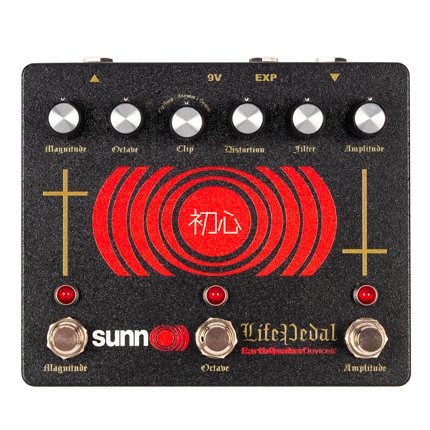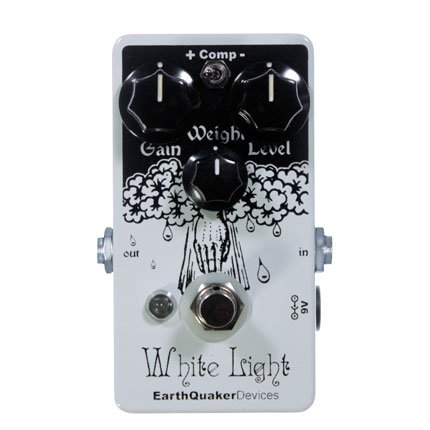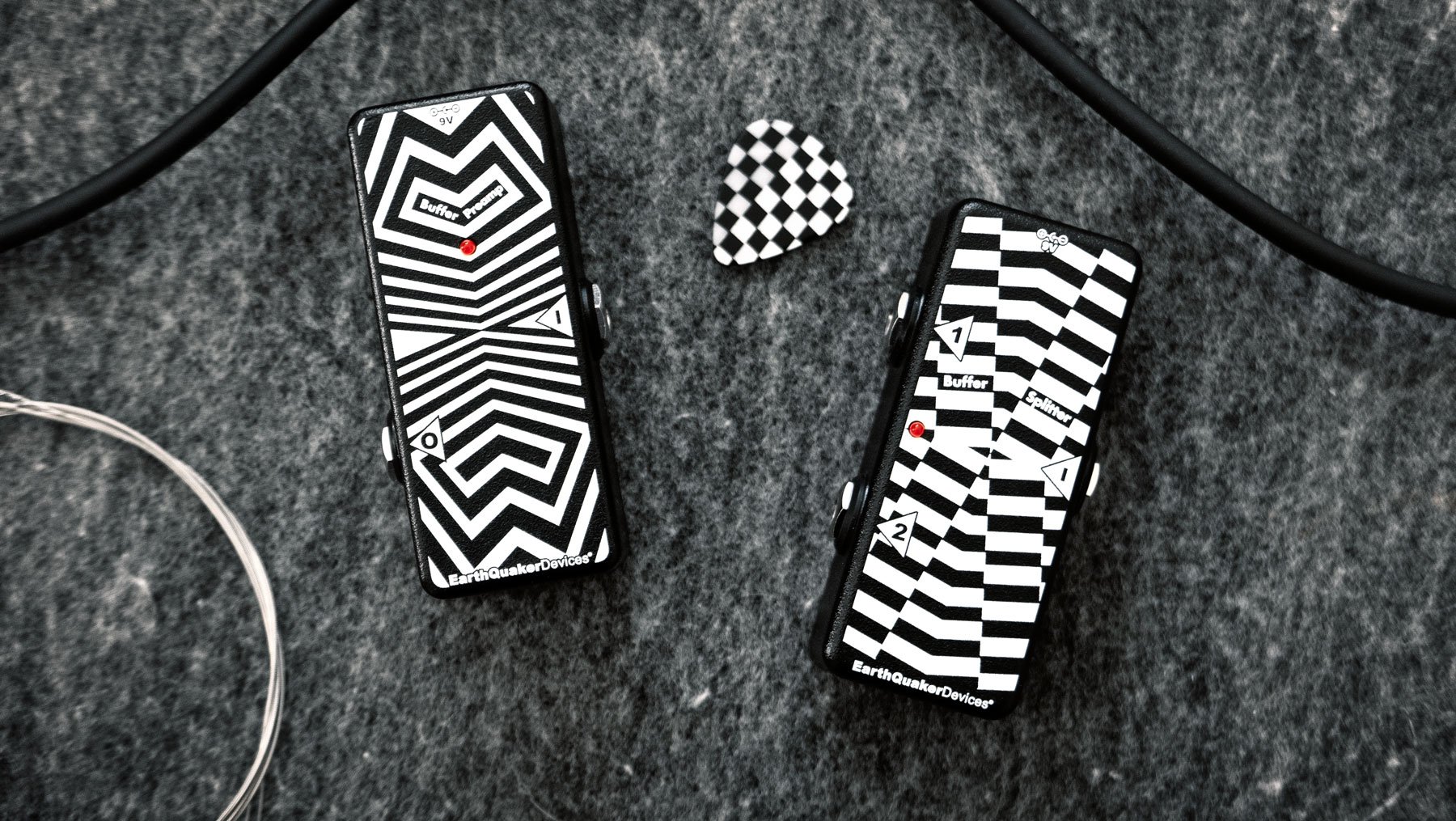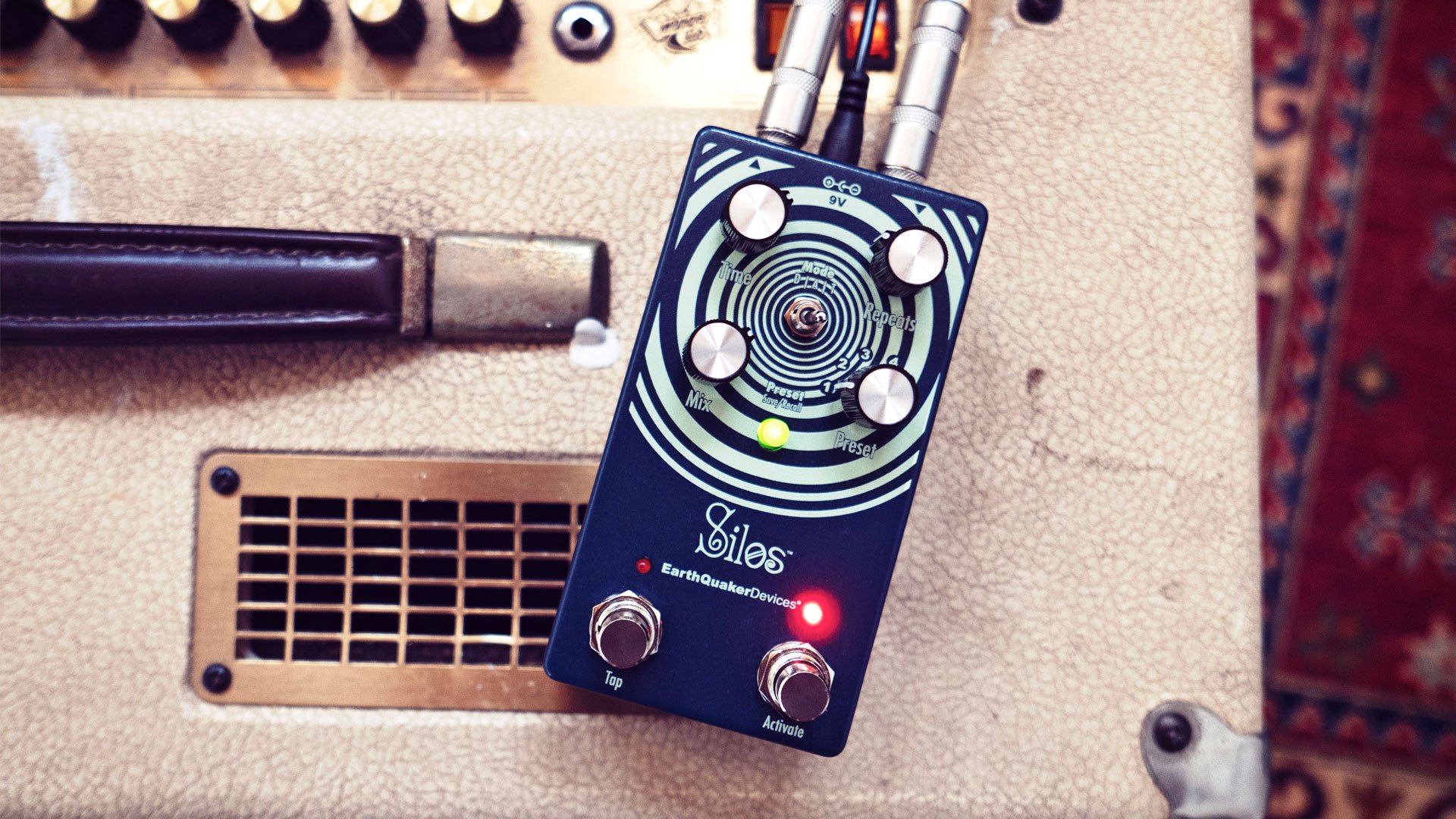EarthQuaker Devices Sunn O))) Life Pedal V3
Jon D’Auria
For almost 25 years, Stephen O’Malley and Greg Anderson have been paving a distinct path by forging their own form of expression as the revered experimental drone metal outfit Sunn O))). Unique in every element of their approach, the duo unleashes powerful performances that are as visceral as they are cathartic, thanks to their intense volume and wide depth of frequencies through walls of amps and the signal chains they’ve cultivated. Their nine albums have redefined metal and popularized once outlier subgenres with powerful compositions focused around tone and the emotions behind them in songs that span up to 20+ minutes in length in almost classical movement forms. Their loyal fan base continues to grow, as they sell out venues all over the world. In short, Sunn O))) is a sonic experience unlike anything of its kind.
In 2019, O’Malley and Anderson decided to take an introspective journey into defining and replicating their sound by collaborating on an effect pedal that would allow players to harness their spectrum of frequencies. Meticulous in nature, the two found like minded EarthQuaker Devices to be the perfect match for such a task. Bonded by similar backgrounds and a truly DIY, hands-on approach to everything they do, the guitarists quickly formed a kinship with EQD founder and president Jamie Stillman. After months of engineering and fine tuning, the Sunn O))) Life Pedal was born. Offering distortion with an analog octave up and boost functions, the pedal carries the sonic DNA of the band and became highly sought out by players searching for their powerful tone. Quickly selling out of the limited run, Sunn O))) and EQD decided to release a second version of the pedal a year later, with minor tweaks to its circuitry and a more compact enclosure to make it an easier fit for crowded pedalboards. To no surprise, this limited run also sold out. With the lull of the pandemic and a desire to create again, the duo decided to refine and evolve the pedal, which gave birth to the recently released Life Pedal v3, which is now a permanent fixture in the EQD lineup.
Photo by Manon Clavelier
Featuring a new look designed by O’Malley, who not only handles all of the visual and aesthetic elements of Sunn O))), but also the appearance of each version of the Life Pedal, the v3’s most notable difference is the addition of a separate footswitch for the octave section. Now with the option to switch it on and off, the octave circuit, inspired by the Shin-Ei FY2 & FY6 units, has been fine tuned to make it more pronounced without losing any of its rich bottom end. The pedal’s core circuit has also been tweaked to provide even more brutally crushing tone, along with two additional clipping options to better adapt the pedal to different rigs. Created to represent the core front end chain used by Sunn O))) to push the threshold of their tube amps, the Life Pedal v3 is a highly customizable juggernaut of a tool that can create everything from moving soundscapes to apocalyptic scores and everything in between. In encapsulating the accumulated 25 years of finely tuned sound from these tone-obsessed innovators, the Life Pedal v3 is so accurate that it has found permanent places on both player’s pedalboards and has even been used solely in their performances.
As the new pedal was unveiled to the public, we caught up with Anderson, who lives in Los Angeles and runs the band’s label, Southern Lord Records, and O’Malley, who lives and works in Paris, France, and provides curation and art direction for his label Ideologic Organ. As they begin preparations to hit the road for a U.S. winter tour, they spoke with us about frequencies and transformations.
How did the concept of the Sunn O))) Life Pedal first come about?
Stephen O’Malley: We’d been approached by a handful of boutique pedal companies asking us to collaborate over the years and we’d always asked ourselves, “Why?” Not because it’s not interesting to make things and collaborate, but it would just be something they’d probably make 50 copies of and it seemed vain to do something like that. But Greg and I kept talking and agreed it would be cool to create some gear.
Greg Anderson: I had the idea to put together a pedal that was a reflection and encapsulation of our tone. Tone is a huge part of what we do. Seeing that the band is named after an amplifier brand is an indication of that. We’re really obsessive about it and I thought it would be cool to have a pedal that was curated from our sound. I started talking to Jamie Stillman about the idea and we nerded out about tone and some of the ideas of what the sound and circuit would be. Talking with Jamie was one of those moments where I couldn’t believe I hadn’t met this person before. He had grown up in the underground punk and hardcore community and had his own record label. He understood a lot about all of the ins and outs and the minutiae of that. We connected on a lot of different levels and have mutual friends. That was really important because I haven’t been able to relate to a lot of the people I’ve met in the music instrument industry. Jamie speaks the same language as us and it was a perfect match. He was excited about it because we are as obsessed and crazy about tone as he is.
Sunn O))) and Jamie Stillman with the Life Pedal V1. Photo by Tim Fitzwater.
SO: Jamie started his company in a similar way that we started our label and band and we both had very DIY backgrounds and it felt like it was kinship. From there, being creative was easy. Instead of making a record we decided to make a pedal. We started to make a design based on a signal path we used in the studio creating Life Metal [2019] and Jamie started making prototypes. I got really into the visual and graphic design of it. I laid out the kind of enclosure it would be, the design of it as well as the box that it came in and the packaging. We went into it and it entirely reflected the aesthetic of Sunn O))) that we’d built for so long.
Then we put out 1,000 of them and they sold out immediately, so they made more and they kept selling out. Julie [Robbins, EQD CEO] came back to us a year later with the idea of making another version that was more pedalboard friendly in size, so we came up with v2. We changed the circuit slightly, but they were just minor tweaks. They all sold out, so we decided to do a v3 as a catalog item so people don’t get pissed off if they can’t get one.
How hands on were you in the creation of this?
GA: Stephen and I have minimal knowledge of the technical side and building of the circuit and all of that electronic stuff, but we curated the sound, and they dialed it in and executed that vision. It was a really hands-on collaboration for the design of the pedal and the graphics. Stephen designed the look of it.
SO: It was big for me because the visual element is a big part of what Sunn O))) is. It’s been a 25-year aesthetic experiment and conceptual art project. Life Pedal is part of that. EQD was on board too. Their entire line of pedals comes from their love and beauty of their aesthetic that they’ve been building for many years. When you see one of their pedals, you know it’s EarthQuaker immediately. There wasn’t any sense of approval needed or a rule book I had to follow; they gave me complete freedom to create it as I wanted.
And how did you ensure that the sound of the pedal was true to your vision?
GA: We tried to clearly articulate exactly what we were going for. We were making a record in Chicago at the time with Steve Albini and during the tracking we were experimenting with a lot of effects and layers and textures. Stephen and I have a core sound we’ve been working with for years, and here and there we add and take things out. A lot of it is gain and saturation and different flavors of that. Some of the details of saturation can be super transparent, and adding and subtracting different textures has an immediate result.
Before we left for Chicago, I packed up two huge tubs full of pedals that were mostly distortions and gains and I sent them over as examples. Some of the pedals that really got a lot of use were the older Japanese fuzz pedals like the Shin-Ei FY2 and FY6, the companion and the fuzz wah without the wah. We used a lot of that mixed in with our core sound, which is the RAT pedal with the LM308 chip. A lot of this raspy, kind of octave tone that was coming from the Japanese pedals made an appearance on that album. There are so many RAT clones out there and we wanted to create something that was unique and had a lot of its own character. It’s a simplistic concept of combining different distortion pedals and achieving different shades of saturation that we were doing in the studio. I’m a big fan and user of the EQD White Light and the Black Eye too. Their boost pedals and gain pedals are great. I was already using those to squeeze even more out of my signal. We wanted to create a pedal out of that sound, which came out as the Life Pedal.
SO: On the v3, Greg and Jamie got forensic with the octave circuit design. They went through many tweaks. As far as the box for v3, we decided to use that shape and put the third button on there, along with the expression. Many people use that expression element in a lot of ways that aren’t necessarily heavy, which is super interesting to hear.
Photo by Al Overdrive
What are the biggest differences between the Life Pedal v1, v2, and v3?
GA: The v1 is aesthetically beautiful. It’s modeled after the Japanese Ace Tone Fuzz Master and I love the enclosure and the fact that the knobs are on the front, but it makes it a little less user-friendly. Especially if you’re on stage or making adjustments quickly. But it looks killer. The v2 was a smaller enclosure, and it was all about making the controls on the top of the pedal more traditional. The v3 has a bigger enclosure, it has the option for the octave where you can bring it in and out and I think the pedal is improved and gives you a lot of options. As far as sound, the v1 and v2 were pretty identical minus a few changes in the circuit. With the v3 there’s an added octave switch on it that I really love. That was something Jamie came up with that I was really happy about.
We thought it would be a good idea to be really hands on with these changes and he wanted our input. I got about 10 pedals in the mail over the course of designing this thing with little stickers and notes on them. I really got into it and took it very seriously. I was so in love with v2 that I wanted the next version to be the same or better; it couldn’t be any less. This version is definitely better. This is the ultimate version of the pedal with all of its refinements and especially the element of being able to switch the octave on and off.
Did final outcome of the Life Pedal v3 match your expectations for it?
SO: I got the first prototype and the last prototype of the pedal. I didn’t put it on stage until I had the finished version, with all of my full stacks and bass amps. Right before that particular show I set the pedal as I thought would be nice and I turned it on, and there was my sound. I didn’t even have to do anything. That’s my tone right there in the box. The v3 is the closest and most familiar thing to my sound. I had a show in Poland a couple of weeks ago, and I set up my pedal board and realized my RAT pedal wasn’t there. It was the first time I hadn’t had that for a show in as long as I can remember. I had the Life Pedal and that did the trick. I didn’t need anything else.
GA: We’ve been developing our sound for 24 years and there’s a comfort level that you reach where you don’t want to switch anything out. We did a show in Los Angeles where we exclusively played that pedal, and I got it dialed in to where I wanted it. I love how the octave sounds and the grind that it gives. That sound has become my tone. I’m extremely happy with it. It goes beyond a regular distortion or boost or overdrive pedal. It has a lot more depth to it. You can take it and dial it in for you and make a sound of your own with it.
What is your favorite way to dial in this pedal so far?
GA: The octave is at 1 o’clock. I have it on at all times. I have the distortion at 1 o’clock also. I have the filter at 10 o’clock because I play a Les Paul and I have the tone rolled all the way off on it, so I try to bring in any sort of high end in the sound that I can get. The filter gives a lot of that. The magnitude channel I keep at noon, the boost I keep at 2 o’clock.
Greg Anderson’s pedalboard
SO: I usually use the magnitude and amplitude side on the switch and have the dirt side pretty straight up. The distortion is a little bit to the left and the gain is a bit to the right. I have it in the Op Amp position. Then on the boost side I have it pretty straight up or at 1 o’clock. I use just a tiny bit of the octave for a saturated tone. The guitars I play have such a high output in their voltage in the way their pickups are wound that I don’t need a lot of that. For me, that setting is somewhat of a clean setting in the realm of our music. It’s very sharp, as I hear it, and I use a volume pedal before that, and the dynamic is super diverse.
Stephen O’Malley’s pedalboard
You use full stack bass amps in your live set up. How does this pedal react to those low frequency conveyors?
SO: Greg and I play the pedal and our amps differently. With my sound, being in a drop A with really heavy strings, my spectrum differs from Greg’s Gibson Gold Top P90. The frequency range of my Travis Bean guitar is more extended, so some of those low bass undertones come through cleaner with the bass amps. With this pedal, it’s just gnarly. The Life Pedal with those cabinets is intense. You can use them in a DI setting to record, but the sound is coming from the heart of the pedal, and will be its best version when it’s in front of a tube amplifier. That’s the temple for that pedal.
Greg, you also play bass. How would you utilize this pedal with a bass guitar?
GA: I’ve been doing a lot of recording over the last couple of years and this is all over everything I’ve recorded. It’s my go-to pedal now. I’ll plug my bass straight into that pedal with nothing else. I even put away my Big Muff, which I’ve always used for bass. The Life Pedal is really full and heavy and raw when it comes to low end.
How do you dial it in for bass?
GA: I use similar settings as I do for guitar, but I adjust the output on channel one. I dial in the filter a little with more treble too. It didn’t take me long to dial it in for bass. I first just plugged my bass into The Life Pedal to keep my chain simple in that moment, but then I realized that I didn’t need any other effects.
How did the process of creating this pedal alter your perspective on your sonic identity?
SO: We didn’t land on a tone and sit on it for 24 years. It’s been an evolution of many, many steps of fine-tuning it through tuning our amps, tuning the saturation, tuning the signal chain and impedance. It’s still a work in progress of finding our tone. That’s part of the thrill of it and that might be why this band continues to exist – because it’s exciting for me and Greg to find these new areas of sound and explore them. The Life Pedal project has been part of that too because it’s brought forth a bit of introspection, like, what is that sound? What are the essential aspects of it? What are those colors? Where is it coming from? How can we describe them, and how can we get there? We’ve gone through three iterations of that project, and it’s all part of our cycle.
What do you love about EQD pedals?
SO: I got into many of EQD’s pedals like the Afterneath and the Ghost Echo. They’re so particular and weird in the best way. Swiss Things is one of the pedals I’ve used the most over the years. It’s always on my pedalboard. I use one of the loops for my wet channel with my OTO BAM and Space Echo and the second goes through a saturation chain. The Black Ash is always on my board too. That’s the pedal I turn on on top of everything when I want to go for the authentic crashing helicopter sound. My friend said that it sounds like you’re digging up a street. It just rips. It’s a mystery because it’s a tone bender circuit but with so much more to it. It’s hard for me to wrap my head around what it’s doing.
GA: I think I own every EQD pedal they’ve ever made. They’re excited about their effects and turning people on to pedals. Any time I use an EQD pedal it’s solid and it does exactly what I want it to do. It always has somewhat of its own flavor to it. If I ever need a sound for anything, I just grab my board and it’s always an EarthQuaker pedal that’s going to get me the sound I’m looking for. There’s never been a pedal I’ve tried of theirs that I’m not feeling. They’re never just “meh.” They’re always doing exactly what I’m hoping they’ll do and they have their own character. I’ve never been disappointed in an EQD pedal. They put so much thought and passion into every little element of their effects. It’s not just a utilitarian function; they have a vibe and an esthetic. Their stuff is never knock-offs, or clones, or just the minimum of what a pedal could be. They always nail what they’re going for.
What is it about drone and experimental metal that attracts you to it as a form of expression?
SO: It’s a bit of a retrospective analysis to reflect on what I liked then. When asked this question, I try to turn it into a thought object on what memory actually is and how practice over a long period of time defines itself. It’s more of a path than anything. There are markers on that path that have changed and influenced that path, but the path itself has defined the substance. It’s often easy to talk about references and influences and where you come from in your formative early musical experiences. At this point in my life, it’s about being obsessed with Swedish death metal and The Melvins when I was 18. That’s great, but it was also 30 years ago. Some things have had much more relativity. It involves the human aspect, the element of exploring sound, but also exploring the world by traveling and meeting people and the generosity of sharing music passions through collaboration.
Your performances are known as transformative experiences for the audience that are much more visceral than a typical show. What are they like from your perspective?
SO: It’s thrilling and it’s also challenging. It’s also a lot of other contemplative states. Sunn O))) is abstract. It’s noise. There are structures and relevancies and musicology, but it’s essentially abstract at its core. All of these aesthetic choices create opportunities to frame concepts to explain stories. Case in point is Life Metal and the way it’s presented. People ride this immense sound energy that’s being liberated from the equipment. Those people are involved by filtering it through their minds and bodies. Whatever my experience is playing the music, that’s going to be a very different experience than any other person has. Every person involved, including the audience, is just as engaged as the band. It’s so subjective. This kind of energy event can create so much creativity in response to the impression. It goes to prove that abstraction is the only fundamental aspect of the universe, and to touch it through music is always going to be fascinating. It’s a primordial experience.
Sunn O))) Online: sunn.southernlord.com
Sunn O))) Spotify: https://open.spotify.com/artist/2e7hYqRjL82c1nIoREHc4J
Sunn O))) YouTube: https://www.youtube.com/@SouthernLord
Sunn O))) Bandcamp: sunn.bandcamp.com
Sunn O))) Instagram: @sunnofficial
Jon D'Auria has been in music journalism for over 16 years as an editor, columnist, staff writer, photographer, web editor, and gear editor. He has conducted over 400 interviews and has been lucky enough to connect with most of his bass heroes. When he's not writing, he keeps busy gigging, running, reading, hanging out with his two huskies, and attempting to teach his toddler slap bass.







